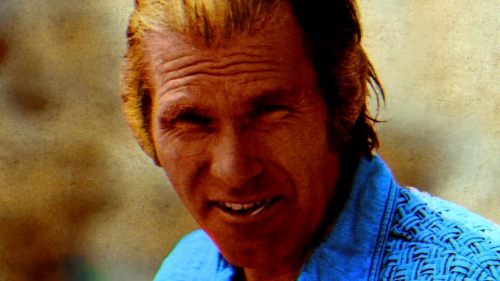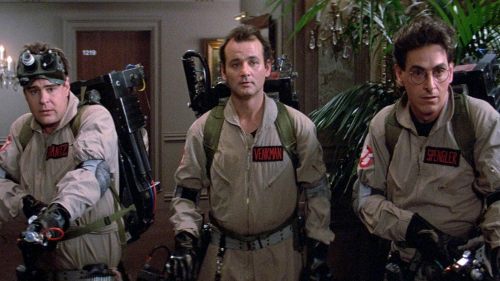Collins’ Crypt: Movies I Love: BEHIND THE MASK
As a lifelong fan of slasher movies, I know the basic formula as well as I know my own name. If the film is a whodunit type, it's not uncommon for me to spot the killer within moments of their introduction, but I never hold this against the screenwriters - it's a sub-genre built on tradition and cliche, for better or worse, and when those things are ingrained it just goes with the territory. But it's very rare that that sort of thing would hamper my enjoyment of a slasher flick; I love them too much and treat them like comfort food, and am sometimes almost charmed by how they follow the patterns of so many others. It's the details that make or break these films - the mask, this or that kill, a particularly novel location (Terror Train may not be the best slasher movie ever made, but I give them full props for doing their thing on a train that almost never stops), and as long as they're bringing something to the table in those departments, I can easily forgive the familiarity of its basic plot.
And that's why I am probably so endeared to films like Behind the Mask: The Rise of Leslie Vernon, because it offers a diversion from those plot points while still catering very much to the slasher audience. I probably don't pull it off the shelf as much as I do the likes of a lesser Friday the 13th entry, but I also don't eat a 16 oz sirloin as often as I eat at McDonald's. The film wouldn't work as well as it did if the slasher sub-genre wasn't populated by films that follow a very basic blueprint, in a way that eclipses even Scream's idea of having fun with its conventions. Whereas Kevin Williamson and Wes Craven offered a traditional slasher film that just happened to take place in a world where the would-be victims had actually seen slasher movies before, Scott Glosserman and Davud Stieve's script literally takes us behind the scenes of a typical slasher movie massacre, focusing on a documentary crew that is giving a glimpse into the world of Leslie Vernon, a masked killer who is prepping his first big killing spree.
Predating Paranormal Activity and [Rec] by a year or two, most of the film is presented as a documentary led by Taylor (Angela Goethals), who has been given complete access to Leslie (Nathan Baesel) as he selects a virginal high school girl and requisite group of friends, preps the chosen location for the slashing (an abandoned apple farm, very effective), and sets about offing the unaware victims one by one. But it's not another Man Bites Dog, because a big part of the fun is that Leslie exists in a world where Michael Myers, Jason Voorhees, etc. are all real guys - not movie characters - and he wishes to join their ranks. It's an important distinction - he isn't inspired by movies (and thus there's no "Movies are to blame" element, thankfully), he just wants to belong to an existing group of real world legends. He's definitely got the look down - his mask and costume are so good it's almost a shame they weren't used in a traditional slasher flick, but if it were a traditional slasher film it would lack one of its key assets: the "behind the scenes" look at how slashers operate!

See, because this world is lousy with unstoppable masked killers that are all more or less the same, there's a kind of routine that they follow, and since the documentary crew is totally in the dark about this process he has a good reason to explain it to them, and in turn us in the audience. So he has to do Tai Chi and cardio to be able to run super fast in order to make up for appearing to be walking whenever a victim looks back at him, and he pre-cuts branches on the trees that are accessible outside the second floor windows so that they will break as soon as a victim tries to use one to escape. And as for the windows on the first floor? Nailed shut ahead of time, and he doesn't have to worry about them breaking the glass because no one ever thinks to do that until they get to the second floor anyway.
And he's right! We've seen those things happen countless times, and it's just part of the deal - again, Behind the Mask is able to be as fun as it is primarily because the slasher movies (even the classics it directly references) aren't pretentious enough to try to avoid these cliches. If you're watching a slasher movie and rolling your eyes that the Final Girl's found weapon breaks the second she tries to use it, or that the killer appears to be dead but isn't, then you're probably just not a big fan of the sub-genre anyway (barring a few exceptions like Halloween and Black Christmas, i.e. the legends). But that means you can still get some enjoyment out of BTM, because even though Glosserman and co. are embracing these tropes and love them as much as any other slasher fan, you can assume that they're mocking them without any of that affection behind it.
That said, I truly think every slasher movie you've ever seen, good or bad, will merely enhance your appreciation of this one. Some of the homages are fairly obvious even to a casual fan, such as Robert Englund's Dr. Loomis-y character, with the same trenchcoat and "he's just as creepy as the killer" demeanor. But when Scott Wilson's retired slasher character Eugene refers to him as "an Ahab" and congratulates Leslie on getting one and thus becoming legit, you realize that Englund's character belongs to a tradition that includes Loomis, but also the likes of Tommy Jarvis, John Clifford, Lefty Enright, and Edmund Purdom's simply named "Father" from Absurd (which was basically a Halloween knockoff, so imagine Loomis as a priest). These characters devote their lives to stopping the unstoppable maniacs of our horror films, and are often just as memorable as their masked killers - it wasn't much of a surprise that Tommy Jarvis, and not one of the Final Girls, was (at least, at first) the only other character besides Jason and his mother to appear in the Friday the 13th game. It was pure genius to cast Englund as this film's version (named Doc Halloran), as his iconic villain roles have made it hard to cast him as heroes, but that unnerving presence is perfect for a creepy Loomis-type that troubles the protagonists just as much as the masked murderer.
Likewise, every virginal Final Girl (or Survivor Girl, as they're dubbed here) you've ever cheered on will intensify the hilarity of one of the film's best twists, which (spoiler, obviously) is that Leslie's target Kelly (Kate Lang Johnson) is not a virgin at all but, if anything, more experienced than anyone else in the movie. Until that point there's nothing to suggest that she's any different than Laurie Strode or Nancy Thompson - she's quiet, she startles easy, she has a job instead of spending her time dating boys, etc. So when Taylor and her film crew open a door and find her vigorously riding reverse cowgirl on some random dude, it's not just a great gag, but it also gets you thinking: how the hell do our favorite slashers - and us in the audience - *know* that our beloved heroines are indeed virgins? Leslie's meticulous planning failed him because he clearly can't learn everything from watching her from the shadows, and neither can we. Maybe Laurie and the others just didn't kiss and tell like their friends did?

And that's another of the movie's strengths, at least for me: it retroactively increases my enjoyment of a number of lesser slashers. Because of my love of these things I end up watching them multiple times even if I'm not a big fan of them (I've seen Halloween: Resurrection, which I despise, more than I've seen any Tarantino film of the past 10-15 years), so sometimes I like to "Vernon-ize" the proceedings and think about Michael Myers or whoever setting up his killing areas, adding a bit to my enjoyment as I watch the film for the umpteenth time. Even better, if you dig into the movie's bonus features on the Scream Factory disc, you'll discover that Eugene is meant to be "Billy" from Black Christmas, so the next time you watch Bob Clark's classic it's kind of fun to think about the killer (who was never identified, if you recall) growing old and making a fine life for himself with a lovely wife (a would-be victim!) and some terrific culinary skills. None of this is "canon" of course, but it's not like we're going to learn much new from these films next time we watch them, so there's no harm in applying the Behind the Mask narrative to this or that old-school slasher flick.
Or if you're more normal than me (good odds) you can simply enjoy the film for what it is and never think about it outside of that viewing. As I mentioned, even slasher haters can find plenty to enjoy here, at least in the first hour when the film is having fun with its traditions. Then it becomes a standard slasher film, dropping the documentary angle (and its camera - we get Super-16 instead of video, and it is glorious) and allowing us to watch Taylor and the others navigate a scenario they saw get planned out, occasionally using that to outsmart Leslie but just as often playing into his hands as so many slasher characters have before them. Yes, Scream did something like this with having Sidney bemoan the girls running upstairs when they should be going out the front door, only to do just that, but the fact that Taylor actually walked through these traps with Leslie and even got him to explain why he was doing this or that thing makes it far more amusing. The idea, at least to me, is that these killers are like master chess players, anticipating your moves and knowing exactly how to counter any one you might take. Just as Happy Death Day found a way to off just about every character (and just once), we still get the body count we crave, even if it doesn't come in the same manner you might have expected.
It's interesting that we get this kind of clever comedic slasher every decade or so - Scream was 1996, Behind the Mask debuted in festivals in 2006 and got released (briefly in theaters) in 2007, and then Happy Death Day came out last year. All three films use the traditions and language of slasher movies to tell a more inventive story than the usual "kids in the woods get offed" kind of deal, but without ever becoming a full blown spoof like Student Bodies or Scary Movie. And I love all three films, but it's not too much of a surprise that this is the one that failed to catch on with the mainstream like the others. The documentary approach was not in vogue at the time, and it was something of a spoiler to tell people at the time that the third act was indeed delivered as a straight forward masked killer movie, so it had an uphill battle even with horror fans, let alone mall crowds who would have been happier with a new Scream film anyway. But just as actual love letters tend not to be too universal, Behind the Mask is a gift to fans that have lived and breathed these films just as much as its creators, and I was happy for an excuse (the new Blu) to revisit it. I feel we're on the verge of a full slasher comeback, and it will be fun to see the film get discovered now that it's part of the almighty Scream Factory family, as fans tend to "blind buy" their titles on good faith. Leslie Vernon may not be as iconic as the killers that inspired him, but he's just as worthy of your admiration.



